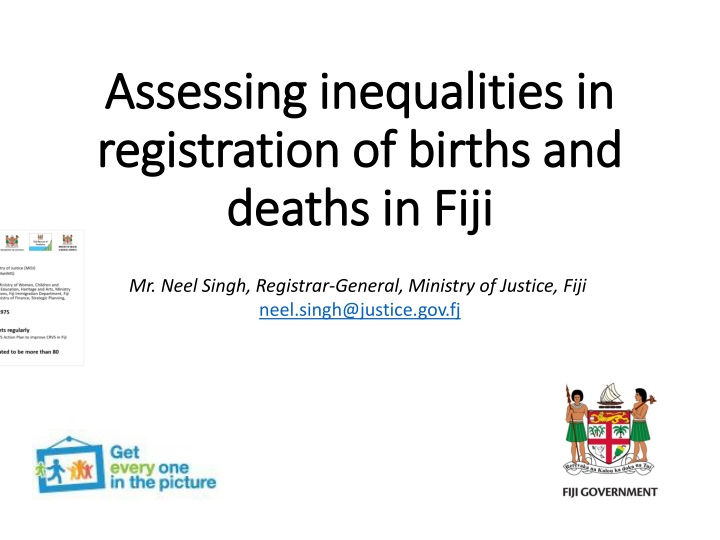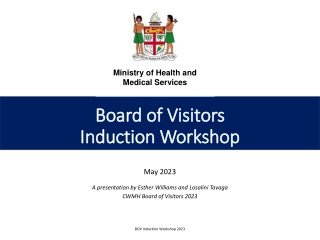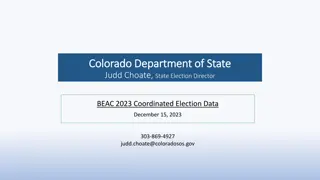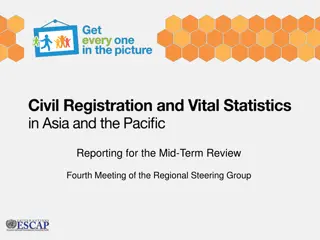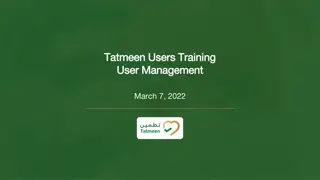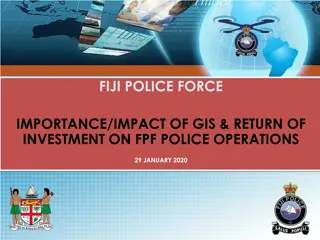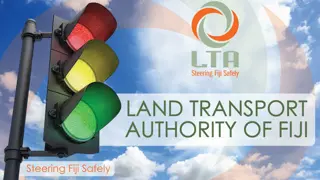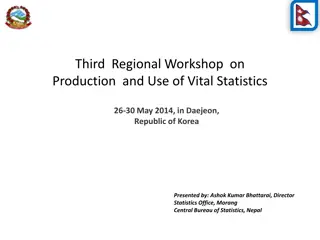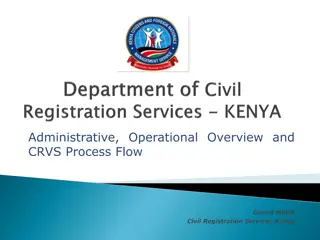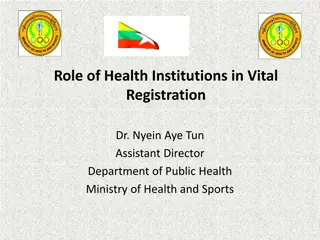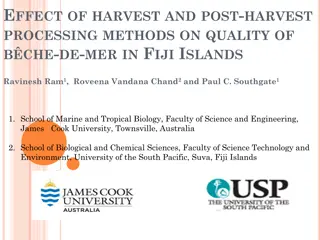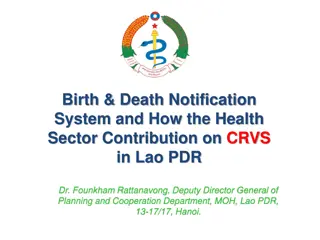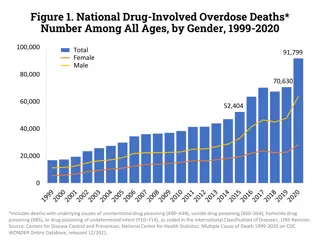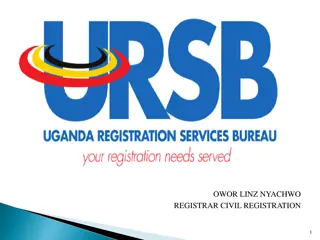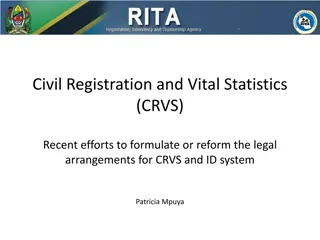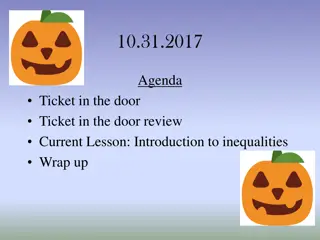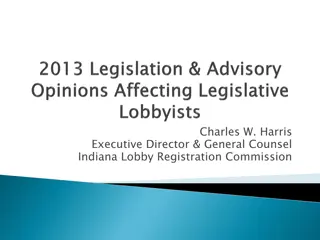Assessing Inequalities in Registration of Births and Deaths in Fiji
Assessing inequalities in registration of births and deaths in Fiji is crucial for ensuring comprehensive civil registration. This assessment, led by the Fiji Bureau of Statistics in coordination with key stakeholders, aims to identify disparities in registration completeness across population subgroups. The findings and policy implications derived from this analysis will contribute to enhancing the overall accuracy and coverage of civil registration data in Fiji.
Download Presentation

Please find below an Image/Link to download the presentation.
The content on the website is provided AS IS for your information and personal use only. It may not be sold, licensed, or shared on other websites without obtaining consent from the author.If you encounter any issues during the download, it is possible that the publisher has removed the file from their server.
You are allowed to download the files provided on this website for personal or commercial use, subject to the condition that they are used lawfully. All files are the property of their respective owners.
The content on the website is provided AS IS for your information and personal use only. It may not be sold, licensed, or shared on other websites without obtaining consent from the author.
E N D
Presentation Transcript
Assessing inequalities in Assessing inequalities in registration of births and registration of births and deaths in Fiji deaths in Fiji Mr. Neel Singh, Registrar-General, Ministry of Justice, Fiji neel.singh@justice.gov.fj
Contents Contents Background Fiji CRVS context Overview of CRVS Inequality Assessment Methodology Data Sources Findings: inequalities in birth and death registration Conclusions and policy implications Next steps
Background Background Ministerial Declaration to Get Every One in the Picture in Asia and the Pacific recognised the need to address disparities in civil registration completeness and coverage of marginalised populations. The Regional Action Framework (RAF) for CRVS in Asia and the Pacific calls upon countries to assess any CRVS-related inequalities experienced by population subgroups. Inequality assessments also key to the realization of the 2030 Agenda for Sustainable Development in terms of both data and social development
Fiji CRVS context Fiji CRVS context Key national stakeholders: Registrar General s Office within the Ministry of Justice (MOJ) Ministry of Health and Medical Services (MoHMS) Fiji Bureau of Statistics (FBoS) Other key stakeholders: Fiji Police Force, Ministry of Women, Children and Poverty Alleviation, Digital Fiji, Ministry of Education, Heritage and Arts, Ministry of iTaukei Affairs, Ministry of Communications, Fiji Immigration Department, Fiji National Disaster Management Office, Ministry of Finance, Strategic Planning, National Development and Statistics Births, Deaths and Marriages Act 1975 Active CRVS Committee which meets regularly The Committee has developed a draft CRVS Action Plan to improve CRVS in Fiji Birth and death registration estimated to be more than 80 percent complete
Fiji is one of the first countries to conduct an in-depth quantitative inequality assessment of civil registration Work was led by Fiji Bureau of Statistics in coordination with other key stakeholders, including Ministry of Justice, Ministry of Health and Medical Services (and other key stakeholders), with support from UNESCAP CRVS Inequality CRVS Inequality Assessment in Assessment in Fiji Fiji
Overview of CRVS Inequality Assessment Overview of CRVS Inequality Assessment project project Objective: To ensure no one is left behind, further investigation needed to understand whose vital events are least likely to be registered A multi-stakeholder team of approximately 30 representatives from relevant CRVS entities in Fiji, led by FBoS Series of in-person workshops between January 2022 February 2023 First Capacity Building Workshop Death Registration Second Capacity Building Workshop Birth Registration Inception Workshop Closing Workshop (January 2022) (February 2023) (March 2022) (November 2022)
Methodology Methodology Final inequality assessment report draws on data sources investigated during a data mapping exercise conducted in 2022: To understand by which variables, registered births and deaths could be disaggregated Once these were identified, the availability of those same variables from other data sources to be used in the denominator (for calculating completeness) were investigated MOJ provided Excel datasets upon request with a variety of different variables which allowed an understanding of how birth and death registration completeness could be disaggregated: Examined differentials by sex, age, ethnicity and mother s marital status Calculating completeness of birth and death registration by different sub-groups using direct calculation methods as the administrative data sources in Fiji were found to be relatively robust
Estimating completeness Estimating completeness Direct calculations used the number of registered births or deaths (by sub-group) from the Registrar General s Office at MOJ as the numerator, divided by the estimated number of births or deaths (denominator) from a variety of different data sources Example: Birth registration completeness ???? ? ????????? ?? ? ??????? ???? ?????? ?????????? ?? ????????? ??????? ???? ? ????????? ???? ???? ?? ???? ?????? ???? ? ?? ???? ???? ?????? =
Data sources Data sources Birth Registration Birth Registration Fiji 2021 MICS: some general findings were taken directly from this household survey For direct calculations, registered births from the MOJ were used in the numerator and recorded (actual) births were taken from the following sources: 1. Recorded births from Ministry of Health and Medical Services (MOHMS) 2. FBoS enumeration data from the 2017 census Other options investigated: Vaccination records from MOHMS School enrolment data from the Ministry of Education (MoE) United Nations World Population Prospectes
Data sources Data sources Death Registration Death Registration For direct calculations, registered deaths from the MOJ were used in the numerator and recorded (actual) deaths were taken from the following source: 1. Recorded deaths from Ministry of Health and Medical Services (MOHMS) Other options investigated: Indirect estimation of deaths United Nations World Population Prospects
Findings: Findings: Birth Birth Registration Registration
Trends in Birth Registration Trends in Birth Registration Impact of Parental Assistance Payment Program (PAPP) from August 1, 2018 July 31, 2020 Trends in birth registration in Fiji, 2010-2020 Registered births 25000 20000 15000 10000 5000 0 2010 2011 2012 2013 2014 2015 2016 2017 2018 2019 2020 Greater than 1 year Within 1 year Grand Total
Birth Birth Registration (Fiji Registration (Fiji 2021 MICS) 2021 MICS) Little difference in registration by sex Children in urban areas (89%) more likely to have had their births registered compared to children in rural areas (84%) The Northern Division had the lowest rates of birth registration for children <5 years (85%) Mother s wealth quintile appeared to have the largest impact: mothers in the poorest WQ had the lowest rates of birth registration compared to all over variables analysed (78%)
Birth registration completeness Birth registration completeness Birth registration completeness for the cohort of children age 0 in the 2017 census 85% 80% 80% 74% 75% 76% 70% 69% 65% 60% 57% 55% 50% Under age 1 (2017) Age 1 year (2018) Age 2 years (2019) Age 3 years (2020) Age 4 years (2021) Both sexes
Birth registration completeness by Birth registration completeness by sex sex Birth registration completeness for the cohort of children age 0 in the 2017 census, by sex 85% 82% 80% 78% 78% 76% 75% 73% 71% 71% 70% 67% 65% 60% 59% 56% 55% 50% Under age 1 (2017) Age 1 year (2018) Age 2 years (2019) Age 3 years (2020) Age 4 years (2021) FEMALE MALE
Birth registration completeness Birth registration completeness by mother s age at birth by mother s age at birth Registration data for births occurring in 2020 and registered by age 1 were compared to NOBs digitized by FBoS combined with MOHMS PATIS+ records Birth registration completeness by age 1 by mother s age at birth, 2020 85% 83% 82% 82% 80% 78% 80% 76% 75% 70% 65% 60% 55% 50% 15-19 20-24 25-29 30-34 35-39 40-44
Birth registration completeness Birth registration completeness Lautoka Health Facility Lautoka Health Facility Birth registration completeness by age 1 for births occurring in Lautoka Health Facility, 2020, by mother s age at birth and marital status 90% 86% 85% 84% 85% 82% 81% 80% 80% 75% 75% 75% 71% 71% 70% 68% 65% 60% 55% 50% 15-19 20-24 25-29 30-34 35-39 40-44 MARRIED SINGLE
Conclusion and Policy Implications: Conclusion and Policy Implications: Birth Registration Birth Registration The economic incentives provided through the PAPP had a significant, positive impact on increasing the number of registrations Continuation of economic incentives should be considered to improve the rate of birth registration completeness for all sub-sets of the population Findings from the MICS and census date were in alignment, showing birth registration was lowest for children under age 1 and increased with age of the child Targeting mothers of infants to register within the legal timeframe (within 1 year of birth in Fiji) should be a key policy focus The MICS found that mothers in the lowest wealth quintile wee the least likely to register births, and there was also a disparity in registration between urban and rural residents Better understanding of the barriers to registration for low-income mothers or those residing in rural areas is key for improving registration among this population Analysis suggested that unmarried mothers and teenage mothers were less likely to register their births Registration processes may be examined an re-designed where necessary to be inclusive, welcoming and free of stigma, regardless of a mother s age or marital status
Findings: Findings: Death Death Registration Registration
Timeliness of death registration Timeliness of death registration Registered deaths by timeliness of registration, 2010-2020 7000 6000 5000 4000 3000 2000 1000 0 2010 2011 2012 2013 2014 2015 2016 2017 2018 2019 2020 Greater than 1 year after death Within 1 year of death
Death registration completeness, Death registration completeness, by sex by sex Death registration completeness within 1 year of death by sex, 2018-2020 82% 78% 78% 75% 73% 64% 61% 58% 2018 2019 2020 Total 2018-2020 Female Male
Death registration completeness, Death registration completeness, by age group by age group Death registration completeness within 1 year of death by age group, 2018-2020 100% 90% 80% 70% 60% 50% 40% 30% 20% 10% 0% <1 1-4 5-14 15-19 20-24 25-29 30-34 35-39 40-44 45-49 50-54 55-59 60-64 65-69 70-74 75-79 80-84 85-89 90+
Death registration completeness, Death registration completeness, by sex and age group by sex and age group Death registration completeness within 1 year of death by sex age group, 2018-2020 100% 90% 80% 70% 60% 50% 40% 30% 20% 10% 0% <1 1-4 5-14 15-19 20-24 25-29 30-34 35-39 40-44 45-49 50-54 55-59 60-64 65-69 70-74 75-79 80-84 85-89 90+ Female Male
Conclusion and Policy Implications: Conclusion and Policy Implications: Death Registration Death Registration Children under the age of 5 years were the least likely to have their deaths registered, likely due to the few economic incentives to register a child s death: children do not possess a pension and have little, if any property to bequeath to their surviving family members Processes to support family members to register deaths and ease the process during their grieving period should be considered A decline in death registration from age 70 and above was also observed A better understanding of why this may be happening is needed, in order to implement interventions to improve registration for older descendants. Encouraging persons to establish a will, outlining their property and wishes for inheritance may be one way in which to empower vulnerable populations and encourage surviving family members to register deaths A differential was also observed by sex, with higher rates of male compared to female deaths registered Education around the importance of death registration may be one possible modality to overcome this differential. Cultural heritage groups or women s groups could be points of access for outreach, encouraging families to register the death of female family members, even when there is no economic incentive to do so
Next Steps Next Steps Further research needed to improve inequalities in birth and death registration (perhaps qualitative assessments) Potential Business Process Improvement (BPI) activities to identify bottlenecks and gaps in the system, to allow for a more efficient and user-friendly interface with the public Development of policy briefs to communicate quantitative evidence in support of civil registration incentives Plans under discussion to standardize the Notification of Birth (NOB) form
Thank You Thank You! ! Q&A Q&A
